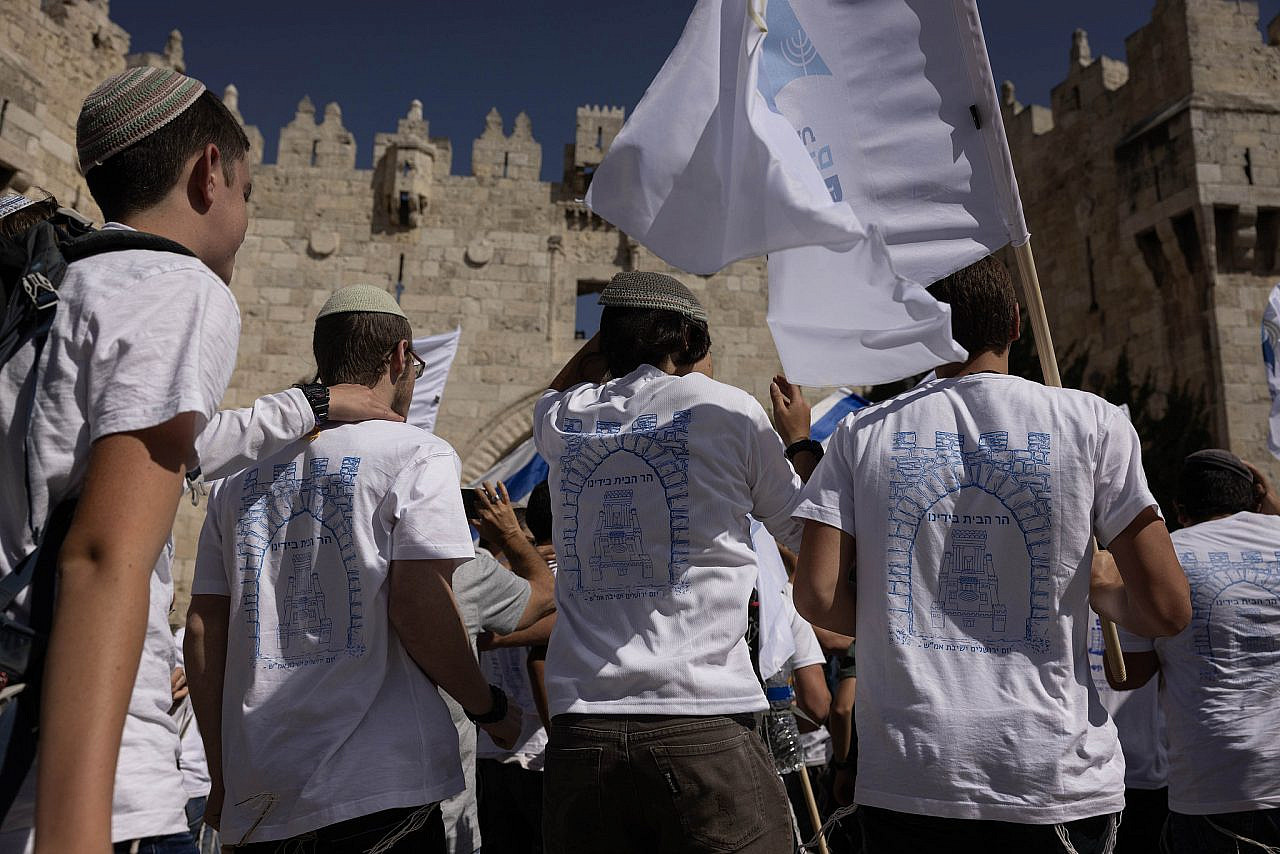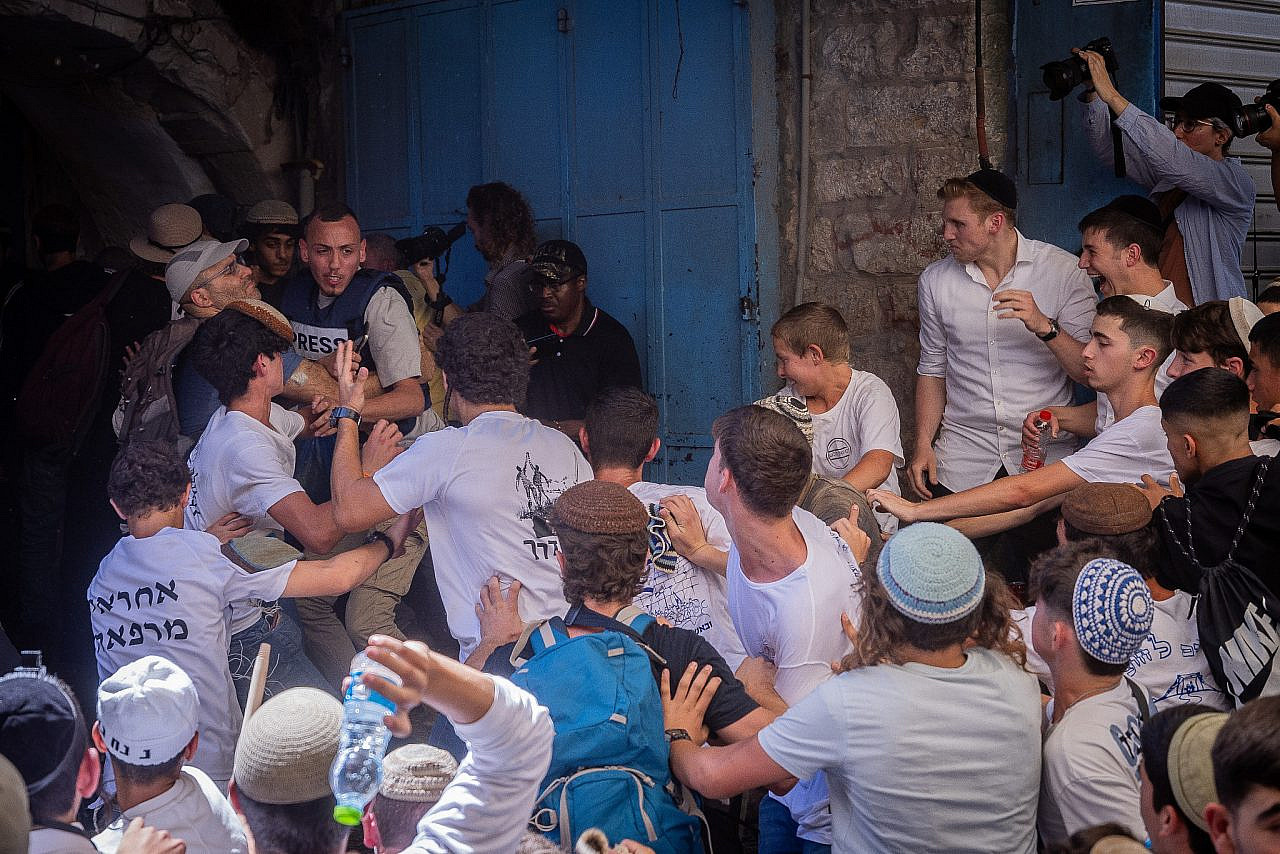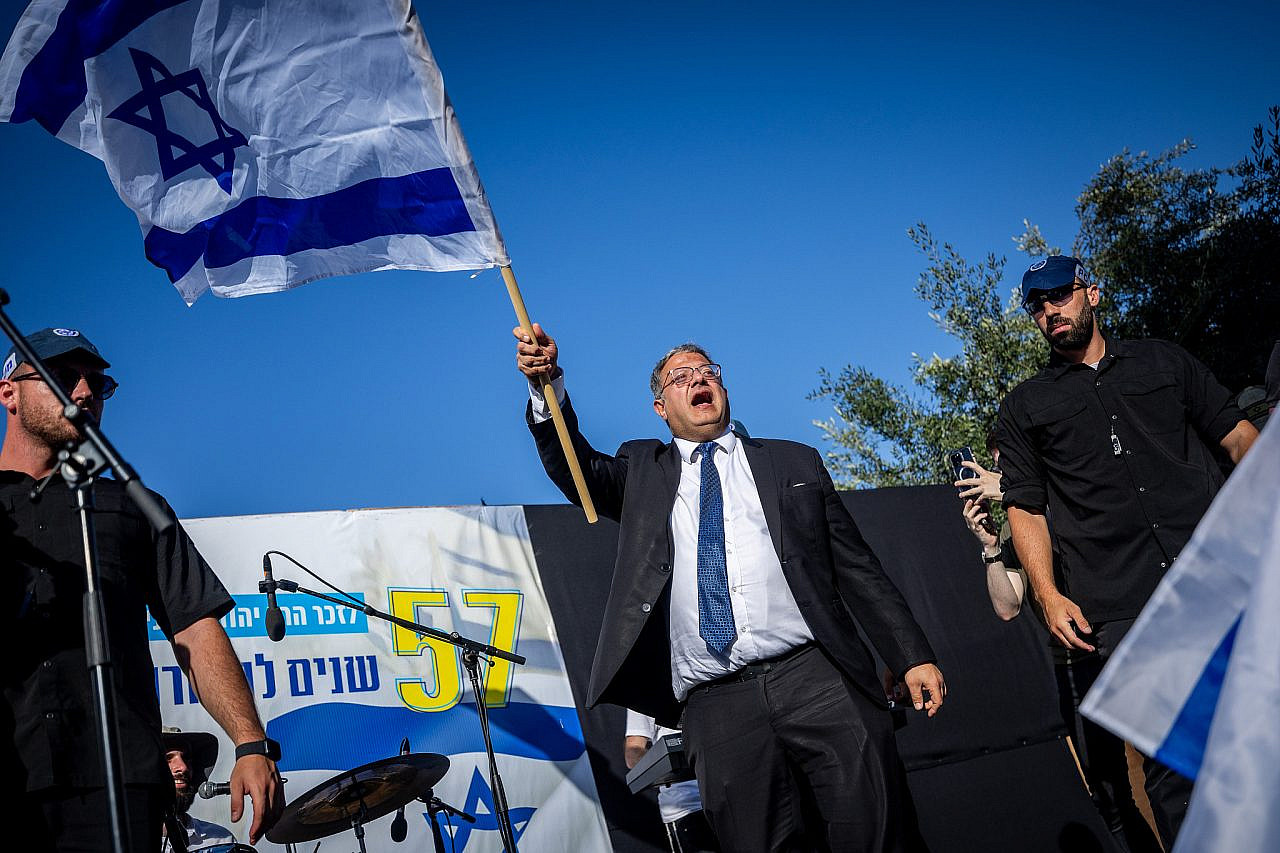The annual “Jerusalem Day” Flag March has long been notorious for its open displays of Jewish supremacy. Every year, in celebration of Israel’s occupation of East Jerusalem in 1967 and continued control over the city, tens of thousands of mostly young Israeli Jews rampage through the Old City, harass and attack Palestinian residents, and shout racist slogans — all under police protection.
However, if in the past it could be said that only some of the participating groups engaged in such behavior, this was the year that it became the norm. Emboldened by their government’s brutal war of revenge on the Gaza Strip, almost every group that amassed at Damascus Gate ahead of the march yesterday afternoon joined in the incitement.
Popular chants included “May your village burn,” “Shuafat is on fire,” “Muhammad is dead,” and the genocidal “revenge” song which includes a biblical injunction turned on the Palestinians: “May their name be erased.” National Security Minister Itamar Ben Gvir and Finance Minister Bezalel Smotrich both arrived at Damascus Gate with their bodyguards toward the end of the festivities, and jubilantly joined the revelers as they sang and danced.
Alongside the chants, some participants carried flags of the Jewish supremacist group Lehava, as well as signs reading “A bullet to the head of every terrorist” and “Kahane was right.” A few made explicit reference to the ongoing Israeli assault on Gaza, calling to “flatten Rafah” and carrying the flag of Gush Katif — the Israeli settlement bloc that was evacuated as part of the 2005 “disengagement,” and which many on the Israeli right hope to see rebuilt. Some held signs depicting the hostages still being held by Hamas in Gaza.

However, the primary focus for the participants was not Gaza, but rather the Temple Mount/Haram al-Sharif. The day started with over 1,000 Jews ascending to the compound, which is holy to both Jews and Muslims and administered jointly by the Israeli police and the Islamic waqf. Many of them carried Israeli flags, and some violated the site’s long-standing “status quo” by engaging in acts of prayer.
They were led by activists who aspire not only to enable Jews to pray on the site but to rebuild a Jewish temple on the site of the Al-Aqsa Mosque and Dome of the Rock. On the march, one youth group wore T-shirts depicting the Dome of the Rock being demolished.
Except for arresting a handful of marchers who attacked journalists, the police — among them the police commissioner and several senior commanders — did nothing to prevent or punish the incitement. This lack of intervention was particularly conspicuous given the post-October 7 crackdown that has seen police arrest and charge hundreds of Palestinian citizens with incitement for expressing opposition to the war in Gaza, whether on social media or in small nonviolent protests.
This double standard is embedded in government policy: what matters is not the content of the speech, but who says it. Thus, while Palestinians are arrested for social media posts, Jews are given free rein to celebrate Jerusalem Day by assaulting Palestinians and calling for their death.
Journalists attacked
The violence began at around 1 p.m. By then, the police had already cleared a route through the Old City’s Muslim Quarter by forcing Palestinian residents into their homes and Palestinian shop owners to close their businesses.

As a result, the only remaining targets toward whom the early revelers could direct their rage were a few journalists who had already arrived to document the march. Palestinian journalist Saif Kwasmi was assaulted by the crowd, while Haaretz journalist Nir Hasson was also knocked to the ground and kicked. But rather than arresting any of the marchers, the police subsequently detained and interrogated Kwasmi, who was accused of incitement.
Most journalists were not able to get so close to the marchers. Before the main crowds arrived, the police forced all of the journalists into a small enclosure overlooking Damascus Gate; according to the police commanders, allowing journalists to accompany the participants through the Old City would have been a dangerous provocation given the marchers’ hostility to the media.
After several hours and numerous appeals to the police commissioner’s office, the journalists were allowed to move among the revelers, but only after being warned that doing so was at their own risk. By then, marchers had already thrown many plastic bottles into the press zone and taunted the journalists from below.
Shortly before the celebrations came to a close, Ben Gvir arrived at Damascus Gate. Surrounded by a heavy security detail which prevented journalists from approaching and asking questions, the minister took the opportunity to declare his total repudiation of the sensitive religious status quo on the Temple Mount/Haram al-Sharif, which has long held that Jews have the right to visit but not to pray on the site.

“I returned here to send a message to Hamas and every house in Gaza and [Lebanon]: Jerusalem is ours. Damascus Gate is ours. The Temple Mount is ours,” he proclaimed. “Today, according to my policy, Jews entered the Old City freely, and Jews prayed freely on the Temple Mount. We say in the simplest way: This is ours.”
Most read on +972
On previous Jerusalem Day marches, Ben-Gvir was just another participant. Today, he is the minister in charge of the police, which is responsible for securing the march and facilitating the ascent of Jews to the Al-Aqsa compound. Although Prime Minister Benjamin Netanyahu distanced himself from Ben Gvir’s stated intention to upend the status quo, it is ultimately the national security minister who enforces the policy.
Jerusalem Day was once an exceptional event, where the racism and Jewish supremacy that always existed within Israeli society were exposed for all to see. But today, as the army’s revenge spree in Gaza continues with the active support of most Israelis, amid surging military and settler violence in the West Bank and campaigns to persecute and silence dissent inside the Green Line, the Flag March has become just one more example of how Israel has normalized extremism.
A version of this article was first published in Hebrew on Local Call. Read it here.






